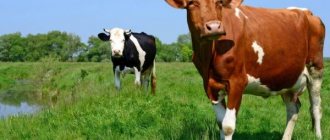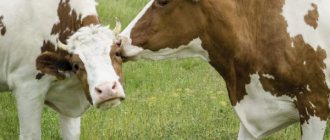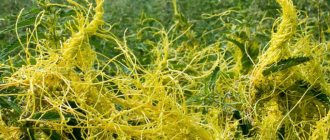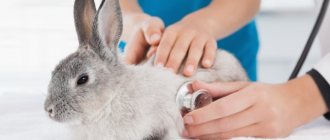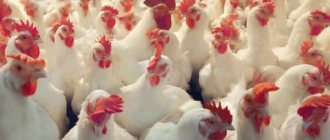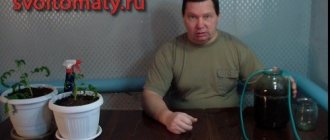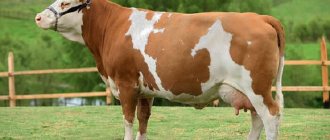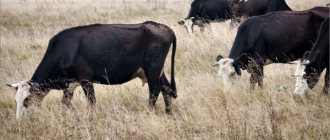Ketosis is a disease in cattle associated with excessive accumulation of ketone substances. And the treatment of ketosis in cows is the topic of our discussion. The disease disrupts the metabolism in the body, which leads to the accumulation of acetone and acids in milk, making the product inedible. The pathology can cause serious damage to livestock farms, since losses of dairy products reach up to 70%. High-milk breeds of cows are most often affected.
Reasons for developing ketosis
With this disease, metabolic disorders occur. Because of this, acetone and acids, which are collectively called “ketones,” begin to accumulate in the body, hence the name of the pathology.
The main reasons for the development of the disease:
- failure of the endocrine system;
- excess protein content in feed and deficiency of carbohydrates;
- frequent stress in animals;
- excessive content of cake and silage in feed;
- mold in feed, root crops;
- reduction in blood glucose levels in cows;
- lack of exercise in the fresh air;
- insufficiency of ultraviolet radiation.
Important! Cows with high milk production are most susceptible to this pathology. Typically, the development of the disease is observed 30-60 days after the birth of the calf. In summer, with the abundance and variety of feed during the grazing period, ketosis rarely occurs.
Cows most often suffer from ketosis between the ages of 4 and 7 years. The basis is the bearing of calves. For this, the cow’s body spends a lot of nutrients and energy. You need to absorb a lot of glucose, but it doesn't come from feed. The body takes it from fat reserves. When fat deposits are broken down in the liver, a huge amount of ketone bodies is formed, which does not have time to be processed.
Experts associate the development of ketosis with an imbalance in animal feed. Treatment and prevention of this disease will be based on changes in the nutrition of cows, taking into account age, condition, that is, pregnancy, lactation.
Symptoms
Rumen acidosis in cows can develop according to the following scenarios:
- spicy;
- subacid;
- permanent;
Acute acidosis
Signs of the disease increase rapidly, especially since the cause of the pathology is almost always known - the cow was deliberately overfed or was not taken care of, and she ate too much on her own. The following signs of acute poisoning are observed:
- The animal loses activity, lies down, breathes with effort, and grinds its teeth.
- Tachycardia develops.
- Chewing of gum stops, peristalsis is absent.
- Muscular tremors occur, turning into convulsions.
- The belly is swollen, the scar is dense.
- Diarrhea develops.
- The cow falls into a coma.
Laboratory studies of ruminal fluid reveal a decrease in pH <6.5. Reserve blood alkalinity falls below normal, and lactate concentration exceeds the permissible limit. Death can occur within 24 hours from the onset of clinical signs.
Subacid acidosis
Most often, it develops in the post-calving period, when the livestock breeder, instead of smoothly changing the diet, sharply increases the supply of starch concentrates. Symptoms develop gradually. Low-grade hypothermia may be observed, which is not observed in the manifest form of the disease. If measures are not taken, udder swelling may develop, progressing to mastitis. There is another danger. If a livestock breeder considers that a cow needs additional protein, which is fair, but forgot to include energy feed in the diet, ketosis develops.
Permanent acidosis
This diagnosis can be made to a significant number of cows, especially highly productive ones, receiving a balanced diet. This occurs due to the individual characteristics of the animal, and also due to the fact that cows are at different stages of lactation, but eat the same food. If the feeding level is not ideal, then the following gradually developing anomalies occur:
- Low productivity.
- Decrease in milk fat content.
- Ruminitis is a chronic inflammation of the scar.
- Laminitis is inflammation of the hoof. Develops several months after the onset of the cause.
- Hepatitis. They are the main cause of premature culling of cows.
- Abortion. With acidosis, the fetus is exposed to chronic poisoning by the acidic blood circulating in the mother's body.
- The birth of hypotrophics. Disease of calves with dyspepsia, defenselessness against infections.
Scheme
Manifestations of ketosis
Symptoms depend on the degree of development of the pathology. The disease can affect many internal organs, and significant deviations will be visible in a biochemical blood test. Animals tolerate diseases differently. Signs may be absent or manifest clearly even with uncharacteristic features.
Main symptoms of ketosis:
- bitter taste in milk, formation of foam;
- perversion of appetite;
- sluggish, apathetic mood;
- milk with the smell of acetone;
- milk yield drops, lactation may stop;
- increased salivation;
- shallow rapid breathing;
- yellowing of the mucous membranes;
- smell of acetone from urine;
- teeth grinding;
- spasm, trembling of individual muscle groups;
- decrease in body temperature;
- alternating diarrhea and constipation;
- high nervousness;
- dullness and matted wool.
The first manifestations of the disease are observed several weeks before calving. Treatment should begin immediately. Without timely medical care, the pathology will quickly progress to the chronic stage. The signs will be less noticeable. Internal organs will begin to suffer. The work of the heart will be disrupted, the liver will increase in size.
Ketosis in cows causes significant damage to the farm. The pathology is not contagious, but animals are fed the same food, so the incidence can reach from 12 to 80% depending on the care and maintenance of livestock. Milk yield may decrease by 15%. Highly productive cows stop lactating and have to be culled for meat. In advanced forms of ketosis, adult animals and unborn calves can die. The number of animals on the farm is declining sharply.
Experts note that the cow, as a ruminant, is predisposed to the development of ketosis. It is important to maintain a balanced feed when feeding animals at all times of the year.
Main symptoms
There are many external symptoms of ketosis. That is why it is possible to identify the disease in the early stages. But it is worth remembering that external symptoms may be similar to other diseases, and an accurate diagnosis is necessary.
Common signs of ketosis:
- the animal's food priorities change. It may begin to eat its litter;
- Breath and urine odor may resemble the smell of acetone;
- the consistency of the milk changes sharply, it becomes bitter;
- lactation stops, milk yield drops noticeably;
- the animal can suddenly lose weight, sometimes even up to 3 kg per day;
- the appearance of the fur changes. It becomes disheveled and dull;
- a hormonal imbalance occurs, the cow does not come into heat, and at this stage infertility begins to develop;
- if you look closely at the skin, you can observe its yellowing;
- the cow suffers from constipation;
- liver and heart dysfunction occurs;
- Laminitis begins to develop and the hooves become dull.
Typically, the first symptoms of the disease may occur in the last few weeks before calving.
Stages of the disease:
- Acetonemia, or acute ketosis.
- Subacute.
- Chronic.
The disease at each stage has not only general symptoms, but also additional characteristic symptoms that relate specifically to this stage.
How to make automatic watering of a plot with your own hands
Acute ketosis can be identified by the presence of some characteristic symptoms.
Symptoms of acetonemia:
- cows experience increased irritability;
- trembling in the limbs;
- spasm in various parts of the body;
- heavy salivation;
- grinding of teeth;
- nervousness suddenly changes to lethargy;
- body temperature decreases;
- milk with the smell of acetone, a bitter aftertaste, and no foam.
If characteristic symptoms are detected, treatment should be started immediately.
During the subacute stage, the cow changes its nutritional priorities. She categorically refuses to eat fresh food. At the same time, she will be drawn to spoiled food and her own bedding. The number of milk yields decreases sharply, or milk production stops altogether. The milk has a distinct acetone smell.
The disease in its chronic form occurs with similar symptoms as in the acute stage. But usually it is less pronounced.
https://youtube.com/watch?v=9SIetMd2IXA
If at least one of the symptoms is revealed, treatment must be started immediately. In order to begin treatment, you should contact a specialist who must make an accurate diagnosis.
Diagnostic measures
Diagnostics allows us to identify the cause of the pathology. A whole range of events is being carried out. It is imperative to analyze the composition of the feed and determine the energy level in the dry food. Cereals should not contain excess starch concentrates. To prevent the development of ketosis, it is necessary to reduce dairy feeds, for example, root vegetables and silage, in the diet of deep-pregnant cows and the first 3 weeks of lactation.
For diagnosis, special express methods have been developed that can be used independently at home. Experienced farmers can identify this disease by external signs, but sometimes it is necessary to call a veterinarian to make a diagnosis. He will take blood and urine tests.
The Lestrade reagent allows you to independently test milk for the presence of ketone bodies. To do this, place the reagent in a clean, dry test tube with a sterile scalpel. Then slowly pour in 10 ml of milk. If a cow is sick, her milk will turn purple. You can take urine for analysis with this reagent.
Diagnostics
If ketosis is suspected, the veterinarian carries out the necessary laboratory procedures (determining the level of acetone bodies in the blood or urine using a special reagent).
Next, it confirms the diagnosis by analyzing clinical signs, test data, and collecting information about the nature of feeding and maintenance.
Then treatment is prescribed, and the owner receives the necessary recommendations.
Treatment options
The treatment plan is determined by the veterinarian depending on the condition of the animal, test data, and symptoms. An integrated approach will help you get a positive result in a short time.
First, nutrition is normalized, the deficiency of which is often the main cause of the development of the disease. The veterinarian prepares the correct diet for a sick animal. It includes the necessary elements in the correct percentage, taking into account the condition of the animal and its energy costs.
To do this, perform the following actions:
- reduce protein in food;
- add fertilizer, for example, ready-made mineral supplements;
- add green grass and fresh hay of good quality to the feed;
- the cows are given vegetables daily (potatoes, carrots, sugar beets, fodder turnips);
- Vitamins A, D and table salt are added to the feed.
It is necessary to reduce the consumption of wheat by animals. It is quickly absorbed in the digestive system and causes fermentation. It is better to include barley and corn and full-fat soybeans in the feed. A proper diet restores normal acid levels. As a result, the functioning of the digestive system is normalized.
Important! Long walks in the fresh air have a beneficial effect on animals, especially on sunny days. Skin massage is also used to restore sweating.
Use of drugs
Changes in diet and walks in some cases do not help a sick animal, and medications must be used. Injections of glucose with novocaine are performed. The amount of medications is calculated according to this scheme. For 100 kg of animal weight you need 0.25 g of novocaine. It is diluted in 300 ml of 20% glucose solution. In severe cases, intravenous glucose injections of 500-600 ml are given 1-2 times a day.
Glucose helps reduce the number of ketone bodies. Additionally, sugar is added to the animal’s drink. The use of Sharabrin's solution is considered effective. This is distilled water (1 liter) with the addition of special substances:
- glucose – 100 g;
- bicarbonate of soda – 13 g;
- caffeine – 0.5 g;
- penicillin or streptomycin – 500 mg.
To remove toxic substances from the body, you need to do an enema with a solution of boiled water with the addition of 5% baking soda. You can give this solution to an animal, diluting it with water.
The work of the heart is supported by subcutaneous injections of caffeine and tincture of white hellebore (diluted 10-15 ml in 1 liter of water). To maintain general well-being, injections of polyminerals and vitamins are given. It is useful to give animals up to 1 kg per head of freshly chopped pine needles. The disease damages the hormonal balance of animals; to correct it, it is necessary to administer oxytocin up to 40 units.
For drug treatment, you need to invite a veterinarian. He will prescribe treatment for each animal individually. With strict adherence to the treatment regimen and dosage of drugs, the cow will quickly recover. It is better not to carry out medical procedures on your own.
Physiotherapeutic methods, for example, udder massage, are used in combination with medications. Quartzing the udder helps strengthen the immune system. Sessions are held every other day. A quartz lamp is installed at a distance of 1 meter from the animal and directed towards the udder. The duration of the procedure is no more than 10 minutes.
Traditional methods of treatment
Traditional methods of getting rid of ketosis must be agreed with a veterinarian. This is done so that the methods of the specialist and the animal owner do not contradict each other. Self-treatment is strictly contraindicated.
Traditional recipes are used only after an accurate diagnosis has been established. Traditional medicine suggests introducing up to 8 kg of beets daily into the diet of a sick animal. This vegetable helps produce alkali, which the animal’s body needs during illness. Also, up to 10 kg of fodder turnips are added to the diet. To maintain sugar-protein balance, a sick cow is given 1.5-2 kg of molasses daily.
First aid for a cow
If a veterinary specialist cannot come yet, and the owners suspect acidosis in the nurse, then you need to provide her with first aid. There are folk remedies that were used in villages in such cases. But you need to understand that these methods may have side effects. If the veterinarian arrives in a day, and the cow’s condition is satisfactory, then it’s not worth the risk. If the doctor is not available for a week, then you need to help the cattle yourself.
If the nurse is completely weak, then you need to dilute half a package of regular table soda in 3 liters of warm water. This liquid is poured into the cow's mouth. Then give up to 1 liter of warm vegetable oil. Then the scar is massaged. The owners need to do this until there are movements of feed masses in the rumen.
Prevention measures
To prevent the development of ketosis, it is necessary to organize a rational, balanced diet. You cannot offer the same food to all animals. On large farms, cows with different productivity are given different nutrition. It is necessary to feed animals in such a way as not to provoke obesity or, conversely, weight loss. Fatness should be average.
When bulk feed is stored for a long time, the vitamins that cows really need begin to break down. To restore nutritional value, fat-soluble biocatalysts “Tetravit” or “E-selenium” are introduced. It is necessary to follow the norm, since exceeding the dosage can provoke acidosis. The Felucen supplement gives positive results.
Ketosis in cows is easier to prevent than to treat. To prevent pathology, the following measures must be taken:
- the food must be balanced and free from mold;
- reduce milking;
- animals, even in winter, should take walks of 2-3 km daily;
- regularly graze livestock in the fresh air;
- cows must have constant access to clean water;
- Root vegetables must be present in the feed; they help restore the acid balance;
- distribute coarse fibrous feed evenly throughout the day;
- feeders must be washed and disinfected regularly;
- do not include large amounts of fat and feed with a high content of butyric acids in the diet;
- it is necessary to give grain crops to animals;
- Animals should be treated kindly and protected from stress;
- Overfeeding of cows should not be allowed.
Increasing the animal's activity is of great importance. Cows must take walks daily. Muscles begin to process ketone bodies after completing a distance of 1 km. For this reason, the animal must walk 2 to 3 km per day.
Each owner must regularly inspect the livestock, monitor the health of the cows, the quality of feed, treat diseases in a timely manner, and carry out preventive measures.
Complications after illness
Animals need ketones as energy reserves. But with a sharp increase in the number of ketone bodies, numerous disruptions occur in the functioning of all internal organs and systems. Without good treatment, ketosis causes complications:
- high mortality of offspring;
- decreased reproductive capacity;
- low immunity in calves;
- sudden weight loss from 15 to 40%.
Ketosis is easier to prevent than to deal with it and its consequences.
According to statistics, cows with high milk yields that produce high-quality milk most often suffer from ketosis. The disease develops 1-2 months after calving. Typically, exacerbation occurs in early spring due to a lack of fresh feed. It is at this time that you need to be attentive to animals and their nutrition. During the period of grazing on pasture, deviations in health are observed less frequently.
Forecast
If therapy started on time, then the prognosis is favorable. If the problem is ignored, you may lose the animal. The treatment is not simple, as it might seem from the description. The main task of animal owners is not to create conditions for animal diseases. You need to be careful about the nutrition of cows, their maintenance, and weight fluctuations. For treatment, you must call a veterinarian. Only a specialist will select an individual nutrition and treatment plan for the cow.
Ketosis affects the most productive cows. Without timely treatment, this pathology can lead to loss of offspring, decreased milk yield, and weight loss. Animals need good care, individual selection of feed, according to their needs and energy costs. For health and to prevent ketosis, cows should walk more than 1 km daily.

